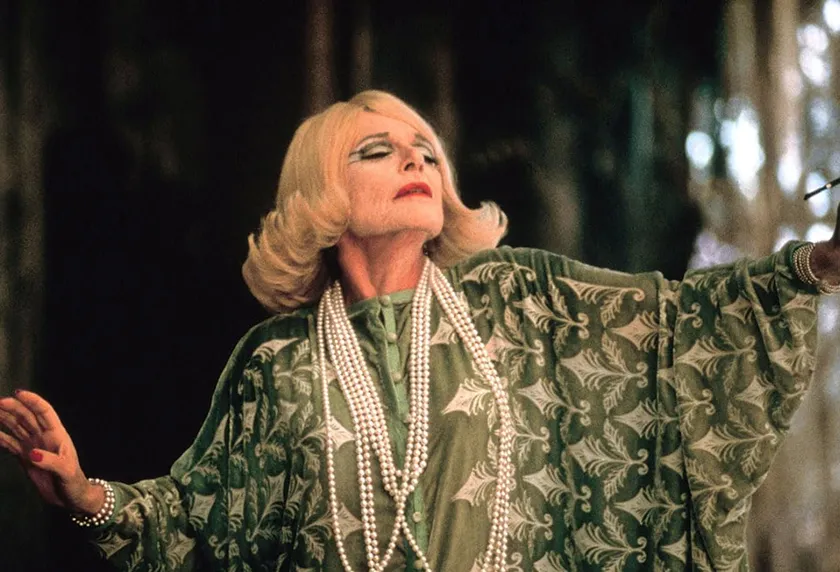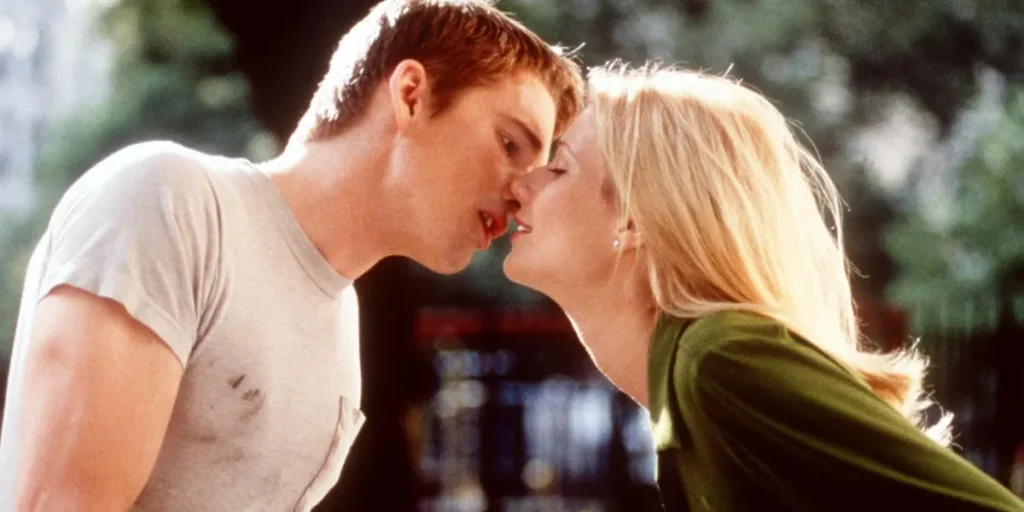Alfonso Cuarón’s Great Expectations (1998), with Ethan Hawke and Gwyneth Paltrow, is a lush, underrated adaptation worth rediscovering.
Director: Alfonso Cuarón
Genre: Romance, Period Drama, Adaptation
Run Time: 111′
Rated: R
U.S. Release: January 30, 1998
U.K. Release: April 17, 1998
Where to Watch: On Digital and on Demand
I wasn’t even old enough to vote when Alfonso Cuarón’s Great Expectations hit theaters, but I distinctly remember its allure; it was brooding and seductive. It had that unmistakable “for older teens” smell, somewhere between an Abercrombie ad and a fine arts major’s daydream. Released just six weeks after Titanic, it never stood a chance. James Cameron’s multi-Oscar-winning juggernaut didn’t just dominate the box office; it redefined what romantic epics looked like. Everything else, especially another sweeping love story, was background noise.
However, watching Cuarón’s Great Expectations now, long after those late ’90s cultural waters have calmed, it feels like the kind of misunderstood film that gets more beautiful with age, and maybe it always was more beautiful than we realized. The film was glamorous, mysterious, and not at all what audiences were expecting in January of 1998, so it’s easy to see how this $25 million production from 20th Century Fox got swept out to sea before it had a fighting chance. It’s a gorgeously flawed gem, one that manages to be genuinely seductive despite, or perhaps because of, its imperfections.
This was only Cuarón’s third feature and second English-language film, following his exquisite yet underseen A Little Princess from 1995. Here, he swings for something bold: a modern-day, sensual reimagining of a Charles Dickens classic first published in 1861. Screenwriter Mitch Glazer (Scrooged) moves the tale from 19th-century London to sultry, muggy 1990s coastal Florida and a neon-soaked New York. “Pip” becomes Finnegan “Finn” Bell (Ethan Hawke, Blue Moon), an orphaned Gulf Coast boy whose life is shaped by a brief but unforgettable encounter with an escaped convict, Arthur Lustig (Robert De Niro, Taxi Driver).
Raised by his uncle Joe (Chris Cooper, The History of Sound), Finn is thrust into the decadent orbit of Nora Dinsmoor (Anne Bancroft, The Graduate), a reclusive heiress marinating in her heartbreak, and her niece Estella (Gwyneth Paltrow, Shakespeare in Love). Finn falls hard and never really recovers. Estella proves as emotionally elusive as she is physically present, all slinky silk dresses and eyes that dare you to look deeper, only to find nothing waiting. Estella’s aunt looms over them like a ghost of ruined love, coaching her niece in heartbreak the way others coach ballet.
Gone are the class divisions of 19th-century England; this Great Expectations trades social commentary for sex, silk, and swirling greens and golds. The story glides from the humidity of Florida to a dreamy New York abstract art world, where Finn, now a painter, is mysteriously offered a gallery show. Finn thinks he knows who his mysterious benefactor is, but it’s all part of a twist, leftover from Dickens that still lands in an emotional sweet spot; however, it’s the heartbreak and disarray leading up to it that feels most honest.
Is this adaptation faithful? Not remotely. From a plot standpoint, this is essentially Diet Rite Dickens: all the themes, half the carbonation. But it understands the feeling of Dickens, of being undone by love, of navigating a world built on illusion. Mitch Glazer’s script strips away some of the novel’s moral scaffolding and leans into sensualism and longing, letting Emmanuel Lubezki’s camera do the emoting for the characters. Characters drift in and out, motivations shift like tides, and logic sometimes gives way to mood. It helps that every frame looks like a painting. There’s a dreamy aesthetic wafting through the entire film, best exemplified in Finn’s art, which features paintings by Francesco Clemente that pulse with color and lust. The fact that the actors sat for Clemente themselves adds a strange, intimate charge to their screen presence. These aren’t just characters; they’re muses.
Hawke embodies aspiration and vulnerability here. Sure, the mop-top wig meant to age him down early in the film proves unfortunate, but beneath it lies a performance full of ache and sincerity. His Finn isn’t a tortured genius or a romantic lead in the traditional sense, just a guy who fell hard for someone who never really saw him. Paltrow, in one of her busiest and brightest years, radiates magnetic, Movie Star energy as Estella. Her chemistry with Hawke is perfection, especially in that famous water fountain kiss that’s all yearning and suggestion, more effective than any bedroom scene. She’s simultaneously the woman of his dreams and the architect of his heartbreak.
Bancroft delivers wickedly good work in one of the film’s nerviest turns. Her Nora Dinsmoor combines Blanche DuBois, Norma Desmond, and Southern Gothic gargoyle into something unforgettable. It’s a performance that flirts dangerously close to camp but always finds its way back to the core tragedy of the character. She could have been a Supporting Actress contender if the film had landed with more critical grace. Cooper, meanwhile, sneaks up on you with one of the film’s most affecting performances. Joe’s quiet integrity and eventual heartbreak deliver the gut punch Finn deserves when he abandons the man who raised him for more glamorous opportunities. De Niro doesn’t get much screen time, but his haunted eyes do most of the work.

Behind the camera, Cuarón’s touch proves unmistakable, though he disappointingly later called the film a failure. His continued collaboration with cinematographer Lubezki results in painterly images drenched in shadow and saturated greens and golds. You feel the Florida humidity. You smell the garden’s decay. The production design, particularly the use of Sarasota’s Ca’ d’Zan mansion as Dinsmoor’s decaying Paradiso Perduto, creates a hypnotically rich atmosphere. Even David Mamet’s uncredited work on Finn’s voiceover, added after the film was completed, provided the movie with just enough scaffolding to keep it upright during its often-tumultuous mid-section.
Donna Karan’s costumes for Paltrow lend Estella an ethereal aura, like someone you know shouldn’t touch but can’t stop watching from afar. Composer Patrick Doyle’s ravishing (and oft-sampled) score swells appropriately, with the orchestral “Kissing in the Rain” underlining the romance without overwhelming it. The film’s soundtrack was a sizable hit, featuring contributions from Tori Amos, Chris Cornell, The Verve Pipe, and Iggy Pop, as well as the film’s most recognizable track, “Life in Mono” by Mono.
For a film so often labeled a misfire, Great Expectations casts a long, unexpected spell. Returning to it years later, I found myself wondering if its reputation might have differed had it been released in a quieter year, away from Titanic‘s shadow. Maybe the timing was bad. Maybe critics were looking for something else. But if you can find it, revisit it now and you’ll find a film willing to risk beauty over precision. It’s not perfect. But it’s easy to fall a little in love with. You’ll be surprised how much lingers.
Great Expectations (1998): Movie Plot & Recap
Synopsis:
A modern adaptation of Dickens’ classic novel following young artist Finn Bell as he navigates love, betrayal, and class in 1990s New York and Florida.
Pros:
- Stunning cinematography by Emmanuel Lubezki
- Magnetic chemistry between Hawke and Paltrow
- Strong supporting performances from Cooper and Bancroft
Cons:
- Some thematic elements get lost in modernization
- Occasionally melodramatic
- Doesn’t fully capitalize on class commentary potential
Great Expectations (1998) is now available to watch on digital and on demand.
Loud and Clear Reviews has an affiliate partnership with Apple, so we receive a share of the revenue from your purchase or streaming of the films when you click on some of the links on this page. This won’t affect how much you pay for them and helps us keep the site free for everyone.

